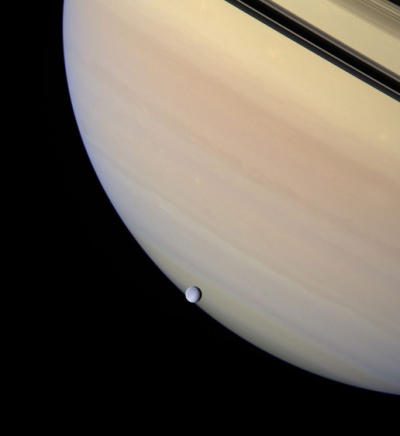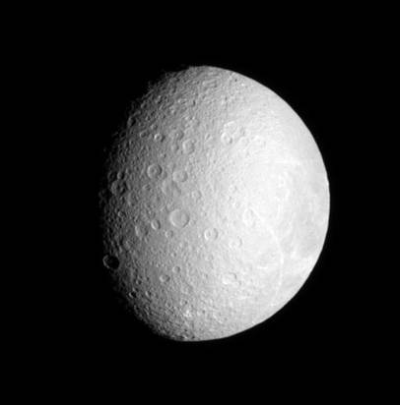04 April 2007

Credit: NASA/JPL/Space Science Institute
NASA recently published a fascinating picture of Saturn, acquired by the Saturn-bound Cassini spacecraft. The image shows Rhea (1,528 km across), Saturn's second largest moon, transiting the planet's gigantic orb.
The spacecraft was looking on the dark side of the Saturnian rings, from about 3° above the ringplane.
The natural-color picture was created using images in green, blue and red filters. The images were acquired with Cassini's wide-angle camera, on 4 February 2007. Cassini was approximately 1.2 million km from Saturn, and 422,000 km from Rhea.
Image scale is 68 km per pixel on Saturn and about 40 km per pixel on Rhea.

A close-up image of Rhea, by the Cassini spacecraft
Credit: NASA/JPL/space Science Institute
Rhea was discovered by Giovanni Domenico Cassini in 1672. It is an icy moon of a low density. Like our Moon (3,476 km across), Rhea keeps one side turned to its parent planet. Its surface shows varied terrain, and is heavily cratered.
Rhea orbits Saturn every 4.5 days, at a distance of approximately 527,000 km. (The Moon orbits the Earth every 27.3 days, at an average distance of about 384,000 km.)
In Greek mythology, Rhea was the wife of Cronus (Saturn) and mother of Zeus (Jupiter), Poseidon (Neptune) and Hades (Pluto).
Further reading
Two Small Moons Align
http://www.bibalex.org/eclipse2006/News_Details.aspx?id=217
Breathtaking Saturn
http://www.bibalex.org/eclipse2006/News_Details.aspx?id=213
Aymen Mohamed Ibrahem
Senior astronomy Specialist